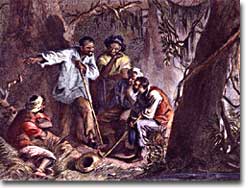6f. "Slave Codes"

Slaves did not accept their fate without protest. Many instances of rebellion were known to Americans, even in colonial times. These rebellions were not confined to the South. In fact, one of the earliest examples of a slave uprising was in 1712 in Manhattan. As African Americans in the colonies grew greater and greater in number, there was a justifiable paranoia on the part of the white settlers that a violent rebellion could occur in one's own neighborhood. It was this fear of rebellion that led each colony to pass a series of laws restricting slaves' behaviors. The laws were known as slave codes.
Although each colony had differing ideas about the rights of slaves, there were some common threads in slave codes across areas where slavery was common. Legally considered property, slaves were not allowed to own property of their own. They were not allowed to assemble without the presence of a white person. Slaves that lived off the plantation were subject to special curfews.
In the courts, a slave accused of any crime against a white person was doomed. No testimony could be made by a slave against a white person. Therefore, the slave's side of the story could never be told in a court of law. Of course, slaves were conspicuously absent from juries as well.
Slave codes had ruinous effects on African American society. It was illegal to teach a slave to read or write. Religious motives sometimes prevailed, however, as many devout white Christians educated slaves to enable the reading of the Bible. These same Christians did not recognize marriage between slaves in their laws. This made it easier to justify the breakup of families by selling one if its members to another owner.
As time passed and the numbers of African Americans in the New World increased, so did the fears of their white captors. With each new rebellion, the slave codes became ever more strict, further abridging the already limited rights and privileges this oppressed people might hope to enjoy.






